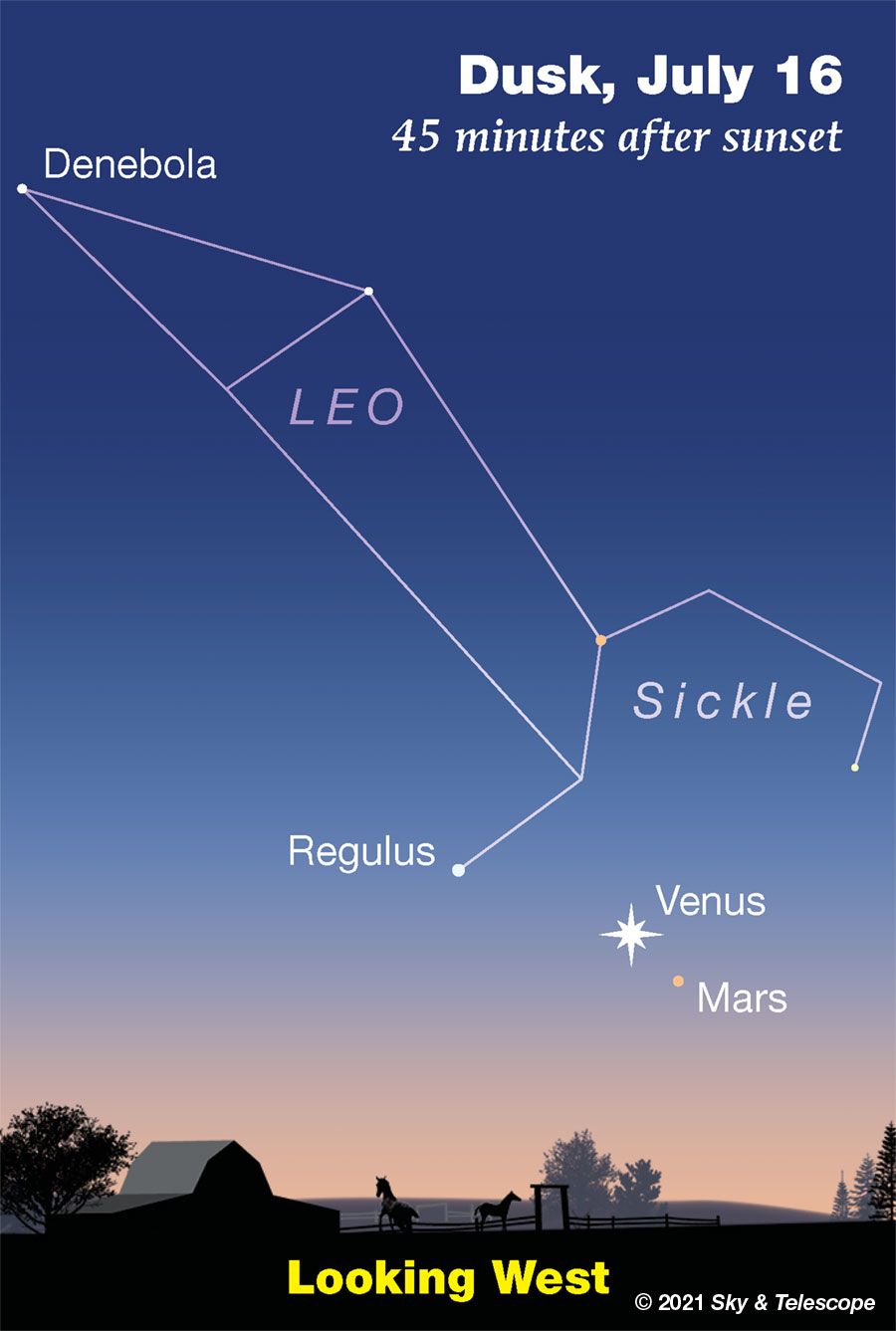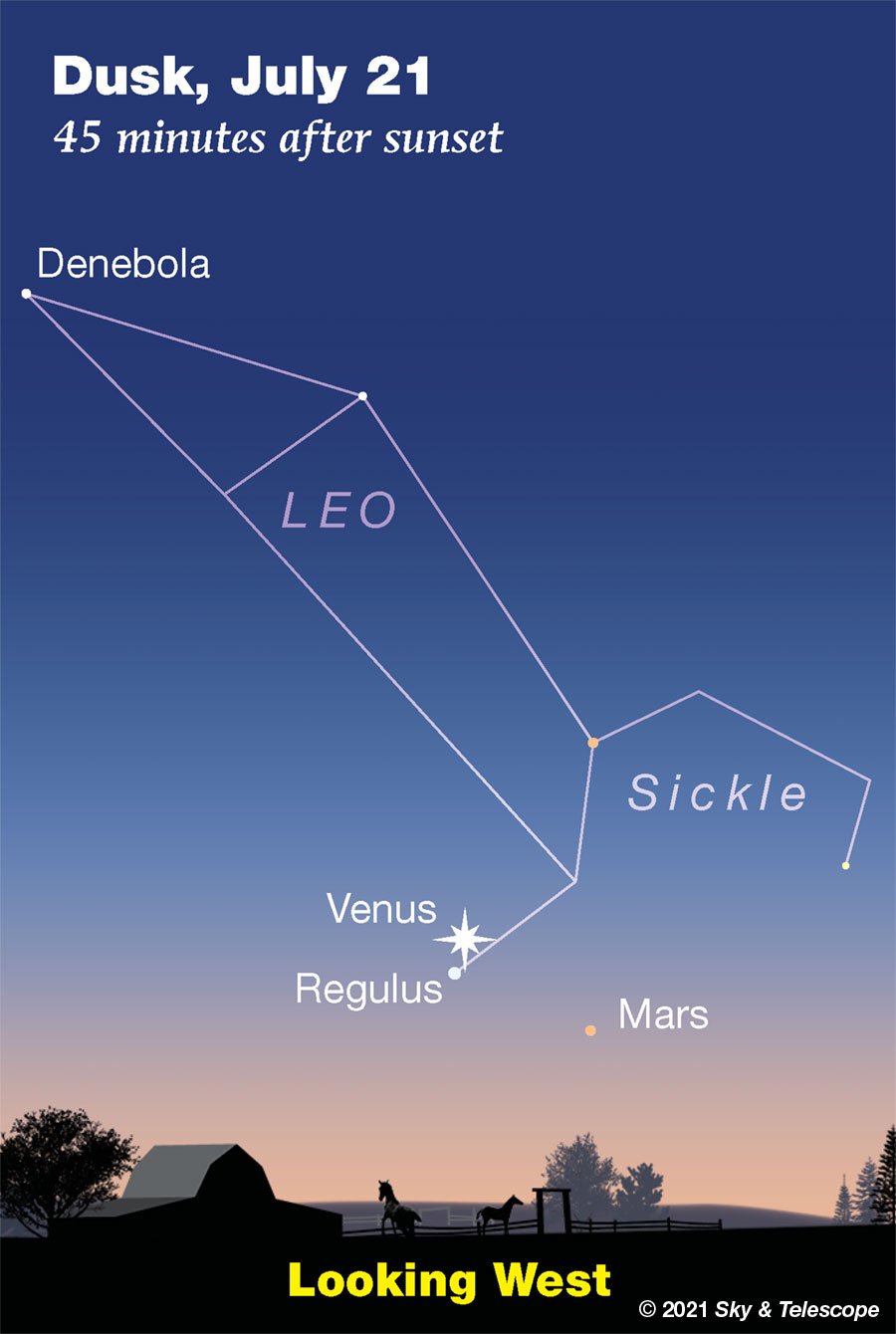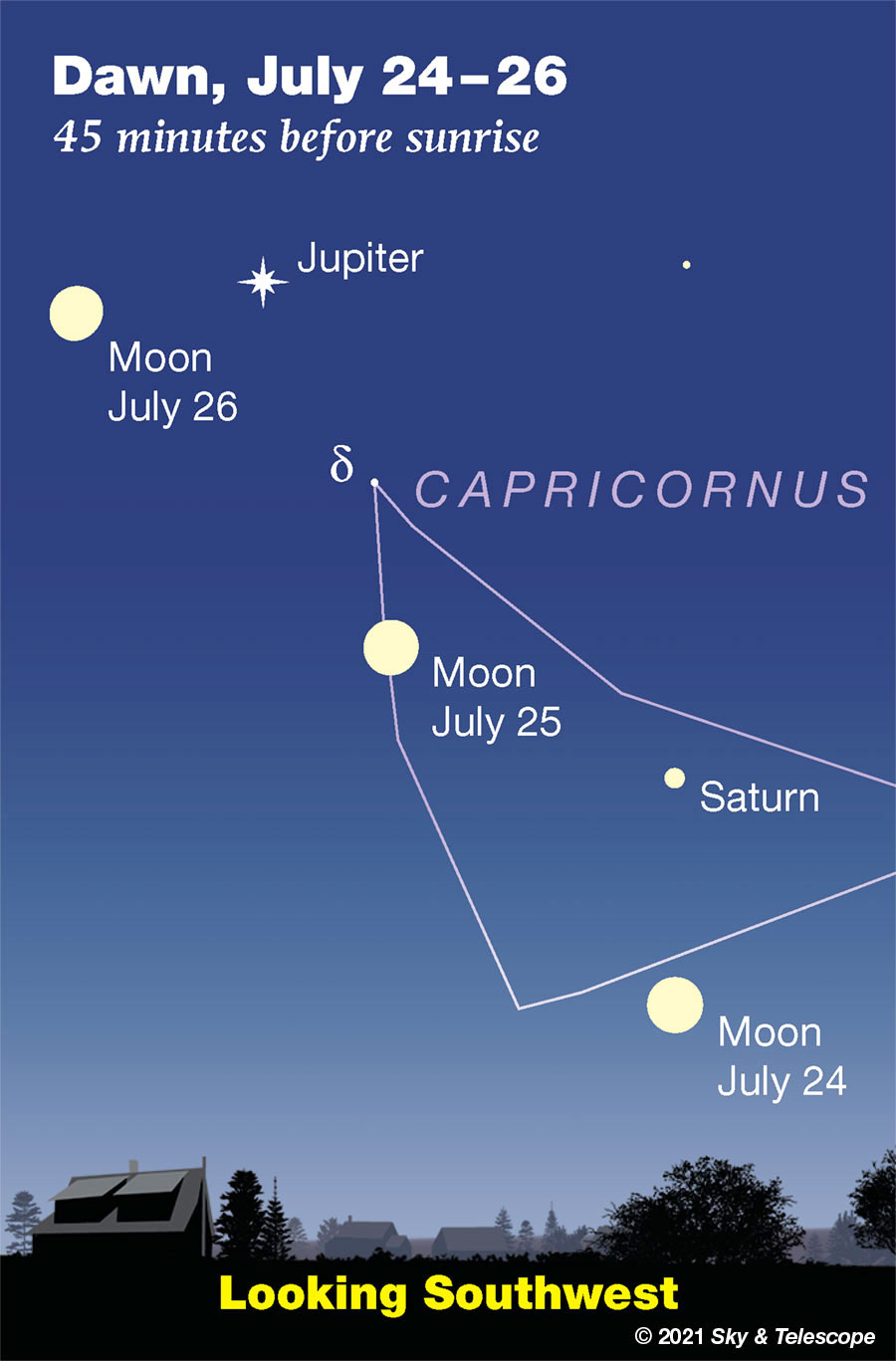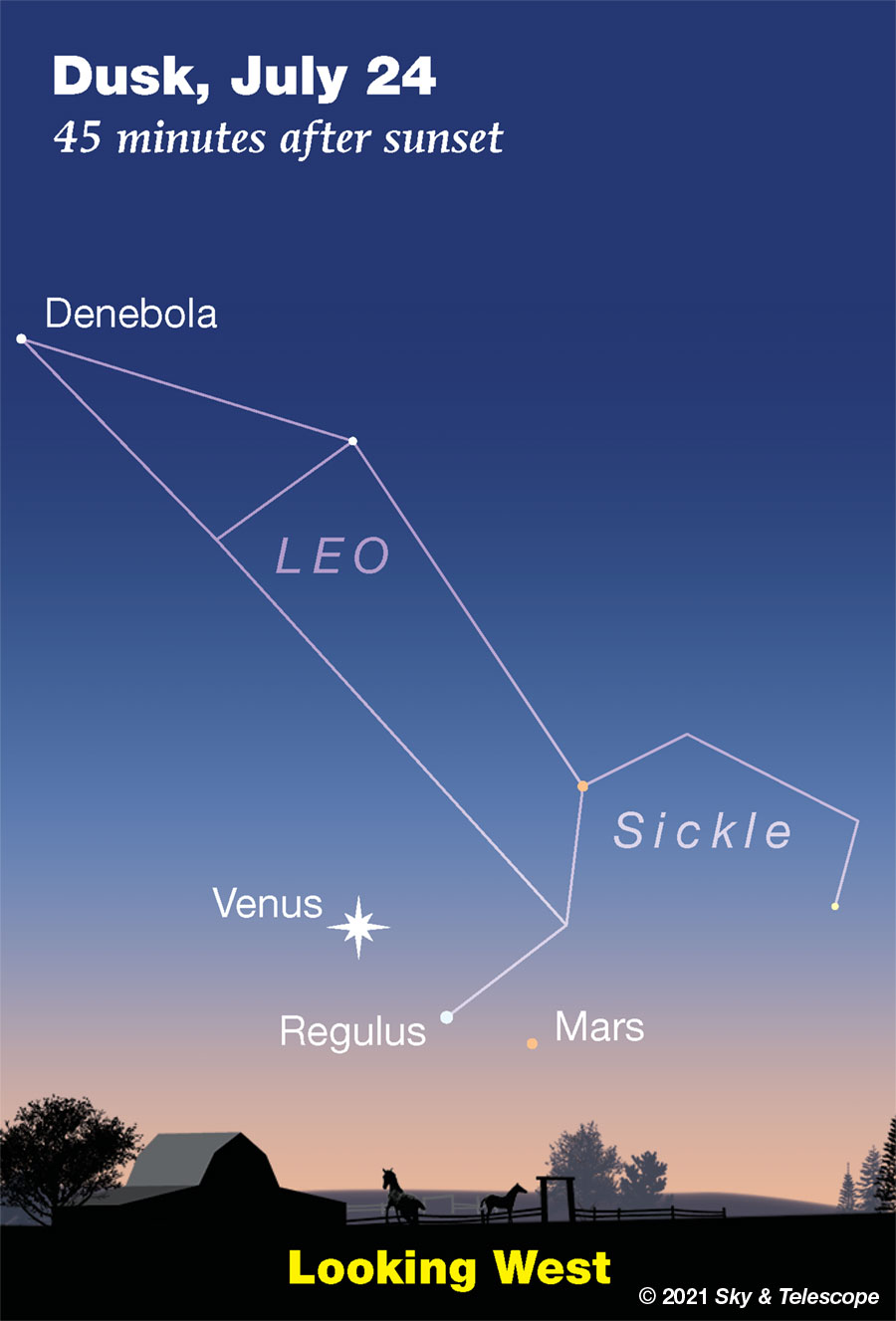Nova Cas update. It's been four months since Nova Cassiopeiae 2021 erupted to magnitude 7.7. It has stayed roughly that bright ever since, making it officially a "slow nova," but with a brightness spike to 5.5 in early May and smaller bumps since. As of July 19th it was 7.0. Charts and comparison stars.
FRIDAY, JULY 16
■ Venus continues to shine low in the western twilight this week. Tiny, distant Mars, a mere 1/200 as bright, is sliding away to Venus's lower right as shown below. Meanwhile, twinkly Regulus, a half magnitude brighter than Mars, is rapidly moving in on Venus from the upper left.

■ First-quarter Moon this evening and tomorrow evening (the Moon is exactly first quarter at 6:11 a.m. on July 17th EDT). Tonight, spot Spica about 6° to the Moon's lower left.
SATURDAY, JULY 17
■ Now the eastward-marching Moon, still essentially first-quarter, shines with Spica to its lower right.
■ Orange Antares and the rest of starry Scorpius are highest in the south just after dark, with Antares about three fists left of the Moon. Don't let the moonlight stop you! Scorpius is bright, and it's rich in double stars for binoculars and telescopes bright enough to shine through. Here's a rundown:
The head of Scorpius is the vertical row of three stars to the right of Antares. The top of the row is Beta Scorpii, a fine telescopic binary: separation 13 arcseconds, magnitudes 2.8 and 5.0.
Just 1° lower left of it is the very wide naked-eye pair Omega1 and Omega2 Scorpii, diagonal from upper right to lower left. They're 4th magnitude and ¼° apart. Binoculars show their slight color difference; they're spectral types B9 and G2.
Upper left of Beta by 1.6° is Nu Scorpii, separation 41 arcseconds, magnitudes 3.8 and 6.5. In fact this is a telescopic triple. High power in good seeing reveals Nu's brighter component itself to be a close double, separation 2 arcseconds, magnitudes 4.0 and 5.3, aligned almost north-south.
■ And the tail of Scorpius, the constellation's other end, is about two fists lower left of Antares. Look for the two stars especially close together in the tail. These are Lambda and fainter Upsilon Scorpii, the Cat's Eyes, 0.6° apart. They're canted at an angle; the cat is tilting his head to the right and winking (Lambda is brighter than Upsilon; they're magnitudes 1.6 and 2.6).
A line through the Cat's Eyes points right or lower right by nearly a fist toward Mu Scorpii, a much tighter pair known as the Little Cat's Eyes. These are oriented almost exactly the same way as Lambda and Upsilon, but they're only 0.1° apart, and fainter: magnitudes 3.0 and 3.5. A cat six times farther away?
SUNDAY, JULY 18
■ Cassiopeia is now well past its bottoming-out for the year. Look for its tilted W pattern slowly moving up in the north-northeast. The farther north you live, the higher it will be.
MONDAY, JULY 19
■ Now the waxing gibbous Moon is butting right into the head of Scorpius, passing between Beta and Delta Scorpii during evening for eastern and central North America. Antares is about 7° to the Moon's lower left.
TUESDAY, JULY 20
■ Now the Moon shines about a fist over the Cat's Eyes and the Little Cat's Eyes. See July 17 above.
WEDNESDAY, JULY 21
■ Low in the western twilight, Venus is now in conjunction with Regulus. The star glimmers only 1/140 as bright as Venus, about 1.1° lower left of it as shown below.

THURSDAY, JULY 22
■ Fourth star for the Summer Triangle. The next-brightest star near the Summer Triangle is Rasalhague, the head of Ophiuchus.
First identify the Triangle. Face east soon after dark and crane your neck high to spot bright Vega. Look two fists lower left of it for Deneb. Three or four fists lower right of Vega is Altair.
Next, Rasalhague. As you still face east, it's three fists to the right of Vega and three fists upper right of Altair.
Admittedly, at 2nd magnitude it's not as bright as the three Triangle stars. But include it and you've got a giant, flattened quadrilateral.
FRIDAY, JULY 23
■ Full Moon (exact at 10:37 p.m. EDT). The Moon is up in the east by late twilight. Look for Saturn about a fist at arm's length to its left.
By dawn on the 24th they shift to the southwest and twist around so that Saturn is above the Moon, as shown below.

SATURDAY, JULY 24
■ Now both Regulus and Mars are well down to Venus's lower right, by 4° and 7° respectively as shown below . Bye-bye!

■ And in the east after dark Saturn shines upper right of the Moon, and Jupiter shines farther to the Moon's left. Again, by dawn this scene of action shifts to the southwest and the pattern rotates clockwise. See the graphic for dawn on July 24–26 above.
■ As summer progresses, bright Arcturus moves down the western side of the evening sky. Its pale ginger-ale tint always helps identify it.
Off to Arcturus's right in the northwest, the Big Dipper scoops to the right.
This Week's Planet Roundup
Mercury this week sinks even lower down toward the east-northeast horizon in bright dawn. But it does continues to brighten: from magnitude –0.8 to –1.5.
Venus (magnitude –3.9) continues to shine low in the west during twilight. Lower left of it is tiny Mars, 200 times fainter at magnitude +1.8. Mars gets lower every day. Both planets set before twilight ends.
Upper left of Venus you'll find Regulus early in the week, moving closer to Venus day by day. It's brighter than Mars by a half magnitude, not even counting their different amounts of atmospheric extinction. It passes 1° from Venus on the 21st.
Saturn (magnitude +0.2, in Capricornus) and brighter Jupiter (magnitude –2.8, in Aquarius) rise in the east-southeast in twilight, Jupiter an hour after Saturn. By late evening they make an impressive duo in the southeast. Jupiter will grab your eye first. Find Saturn 20° to its upper right.
They're highest in the south, at their telescopic best, around 2 a.m. daylight saving time. See "Action at Jupiter" in the July Sky & Telescope, page 50, and "Saturnian Challenges" starting on page 52. They'll reach opposition next month, so they're already about as close and big as they'll get.
Uranus (magnitude 5.8, in Aries) is well placed in the east before dawn begins.
Neptune (magnitude 7.8, in Aquarius 22° east of Jupiter) is higher in the south-southeast before dawn begins.
All descriptions that relate to your horizon — including the words up, down, right, and left — are written for the world's mid-northern latitudes. Descriptions that also depend on longitude (mainly Moon positions) are for North America.
Eastern Daylight Time, EDT, is Universal Time minus 4 hours. Universal Time is also known as UT, UTC, GMT, or Z time. To become more expert about time systems than 99% of the people you'll ever meet, see our compact article Time and the Amateur Astronomer.
Want to become a better astronomer? Learn your way around the constellations. They're the key to locating everything fainter and deeper to hunt with binoculars or a telescope.
This is an outdoor nature hobby. For an easy-to-use constellation guide covering the whole evening sky, use the big monthly map in the center of each issue of Sky & Telescope, the essential magazine of astronomy.
Once you get a telescope, to put it to good use you'll need a detailed, large-scale sky atlas (set of charts). The basic standard is the Pocket Sky Atlas (in either the original or Jumbo Edition), which shows stars to magnitude 7.6.

Next up is the larger and deeper Sky Atlas 2000.0, plotting stars to magnitude 8.5; nearly three times as many. The next up, once you know your way around, are the even larger Interstellarum atlas (stars to magnitude 9.5) or Uranometria 2000.0 (stars to magnitude 9.75). And be sure to read how to use sky charts with a telescope.
You'll also want a good deep-sky guidebook, such as Sky Atlas 2000.0 Companion by Strong and Sinnott, or the bigger (and illustrated) Night Sky Observer's Guide by Kepple and Sanner.
Can a computerized telescope replace charts? Not for beginners, I don't think, and not on mounts and tripods that are less than top-quality mechanically, meaning heavy and expensive. And as Terence Dickinson and Alan Dyer say in their Backyard Astronomer's Guide, "A full appreciation of the universe cannot come without developing the skills to find things in the sky and understanding how the sky works. This knowledge comes only by spending time under the stars with star maps in hand."
![]() Audio sky tour. Out under the evening sky with your
Audio sky tour. Out under the evening sky with your
earbuds in place, listen to Kelly Beatty's monthly
podcast tour of the heavens above. It's free.
"The dangers of not thinking clearly are much greater now than ever before. It's not that there's something new in our way of thinking, it's that credulous and confused thinking can be much more lethal in ways it was never before."
— Carl Sagan, 1996
"Facts are stubborn things."
— John Adams, 1770
 4
4









Comments
Rod
July 17, 2021 at 8:24 am
A note from my stargazing log for this morning. [Observed 0030-0130 EDT/0430-0530 UT. First Quarter Moon 17-July-2021 1011 UT. Jupiter opposition 19-August-2021, Saturn opposition 02-August-2021. I enjoyed some views of Jupiter, the Galilean moons, and some stars in the 10th - 11th apparent magnitude range tonight near Jupiter in the eyepiece. At 71x, the true FOV a bit more than 1-degree. While I viewed, near 0050 EDT/0450 UT, a meteor streaked by heading south just past Jupiter. I estimate apparent magnitude near mv + 1.0 based upon how bright Saturn was, about mv + 0.3 or so. Jupiter cloud bands visible. I did not use planetary filters because I was testing Stellarium and Starry Night sky charts that showed 10 to 12th apparent magnitude stars visible within a one-degree field around Jupiter’s position. There were some faint stars visible like TYC5806-1226-1 that Starry Night shows mv + 10.96, close to 18 arcminute angular separation from Jupiter’s position in the sky. SIMBAD portal indicates stellar parallax 1.4003 mas and mv + 10.97 for the star. The star's distance a bit more than 2300 light years from Earth using stellar parallax provided. Saturn was enjoyable view with other 11th magnitude stars visible, ring system, and the moons Titan and Rhea visible. While observing early this morning, a fox was out nearby barking at me. I shined my red light and the fox eyes lit up, staring back at me. The fox went across the road to a small farm with chickens and chicken coops setup about 200 yards away from my location. There were some dogs out guarding the chickens 🙂 Days are hot with temperatures running 33C or so. Not much stargazing in the evening because of heat and humidity along with haze. The constellation Delphinus was visible including Kappa Delphini star mv + 5.06 so. This was not bad observing but not the best either. While the heat is on now, I am not using my 10-inch Newtonian with the Dob mount system. I use the lighter weight 90-mm refractor telescope with tripod stand.]
You must be logged in to post a comment.
Rod
July 17, 2021 at 12:45 pm
I went back and checked Starry Night and Stellarium. At 0050 EDT this morning, the Perseid radiant was up at my location in Maryland, south of Annapolis in a rural area along the Patuxent river farms. Perhaps I observed an early Perseid meteor streak by Jupiter. It was fast moving, and traveling away from the radiant. Perseids peak this year 12-August and flash by some 59 km/s.
You must be logged in to post a comment.
mary beth
July 18, 2021 at 11:10 am
How exciting! You and the fox had a very interesting night! Wonderful that you saw the shooting star ( we have a cat named that, she streaks by so fast!). Hopefully this is just the beginning of a very prolific Perseids shower. Do you think you’ll be able to see any of the Delta Aquariid shower, or are you too far north?
You must be logged in to post a comment.
Rod
July 18, 2021 at 11:59 am
Delta Aquarids likely mary beth. I checked using Stellarium and Starry Night for 29-July, 0200-0500 EDT. The radiant is up and near Jupiter too. Also the waning gibbous Moon is up in Cetus too 🙂 Observing Aquarids, the radiant close to Jupiter's sky position could be interesting but need to catch quickly before they zip to far from Jupiter's position. It would be interesting to see some meteors move quickly away from near Jupiter's position in Aquarius. Perhaps someone will get a great photo here 🙂
You must be logged in to post a comment.
You must be logged in to post a comment.